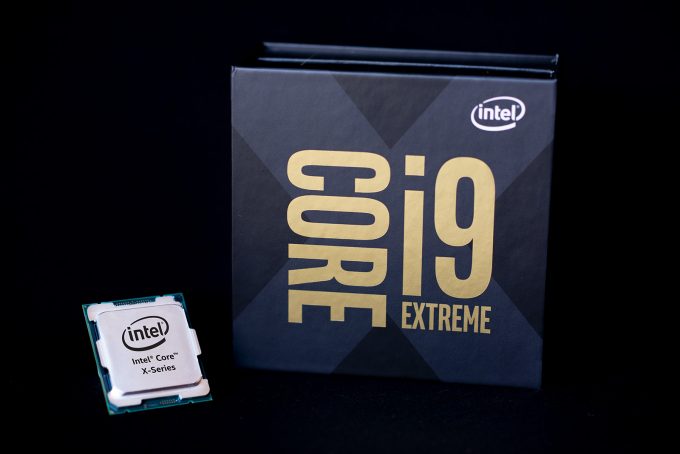- Qualcomm Launches Snapdragon 4 Gen 2 Mobile Platform
- AMD Launches Ryzen PRO 7000 Series Mobile & Desktop Platform
- Intel Launches Sleek Single-Slot Arc Pro A60 Workstation Graphics Card
- NVIDIA Announces Latest Ada Lovelace Additions: GeForce RTX 4060 Ti & RTX 4060
- Maxon Redshift With AMD Radeon GPU Rendering Support Now Available
Cascade Lake Effect: A Performance Look At Intel’s Core i9-10980XE

We’ve reached the third generation of eighteen core desktop processors from Intel, with the launch of the new Core X-series, and its flagship Core i9-10980XE. Even with a bump to the max Turbo clock, and an increase of officially supported memory speed and total density, the most notable thing about Intel’s latest flagship is actually something else: its sub-$1,000 price tag.
Page 1 – Intel Core i9-10980XE Review
Anyone who’s been contemplating building a new PC should be grinning ear-to-ear with the onslaught of CPU releases happening this month. We kicked November off with a look at Intel’s gamer-focused Core i9-9900KS, and we’re now greeting this rare 3AM embargo time with a look at the company’s newest eighteen-core processor, built on the Cascade Lake architecture.
The Core i9-10980XE is the third generation of Intel’s eighteen-core processors for desktop users, but it’s the first to come in at under the $1,000 price point. We undoubtedly have a certain resurgent competitor to thank for this, because as soon as eight-core processors became feasible for the mainstream, a core explosion happened.
A few years ago, a sixteen-core processor would sound dreamy, but today, they’re readily available. It’s a great thing, too, considering creation workloads are picking up in popularity – and many of those love big processors. AMD has even managed to take things to the next level, offering processors with up to thirty-two cores, and a threat of a sixty-four core on the horizon. CPUs are definitely fun again.
The launch of Intel’s new Core X-series happens to occur on the same day that AMD’s launching its third-gen Ryzen Threadrippers. As such, a review of Intel’s latest enthusiast chip six hours ahead of the Threadripper launch means this review is going live with limited data, and in fact, it’ll be far lighter on commentary than usual, simply due to the next content needing to get written for later today.
Originally, Intel and AMD shared the same embargo time, but Intel pulled its own ahead six hours. At the time of this writing, our Threadripper testing is not complete, but it is on the Linux side. We thus plan to greet the Threadripper launch later today with a Linux look that will also include the i9-10980XE. We’ll then follow-up with our full Windows benchmarking look once testing is complete.
Here’s Intel’s current line-up, which features models from the mainstream Core platform:
| Intel Processor Lineup | |||||||
| Cores | Clock (Turbo 3.0) | L3 | Memory | IGP | TDP | Price | |
| Core X-Series | |||||||
| i9-10980XE | 18 (36T) | 3.0 GHz (4.8) | 24.75MB | Quad | No | 165W | $979 |
| i9-10940X | 14 (28T) | 3.3 GHz (4.8) | 19.25MB | Quad | No | 165W | $784 |
| i9-10920X | 12 (24T) | 3.5 GHz (4.8) | 19.25MB | Quad | No | 165W | $689 |
| i9-10900X | 10 (20T) | 3.7 GHz (4.7) | 19.25MB | Quad | No | 165W | $590 |
| i9-9980XE | 18 (36T) | 3.1 GHz (4.5) | 24.75MB | Quad | No | 165W | $1,979 |
| i9-9960X | 16 (32T) | 3.5 GHz (4.5) | 22MB | Quad | No | 165W | $1,684 |
| i9-9940X | 14 (28T) | 3.8 GHz (4.5) | 19.25MB | Quad | No | 165W | $1,387 |
| i9-9920X | 12 (24T) | 3.4 GHz (4.5) | 19.25MB | Quad | No | 165W | $1,189 |
| i9-9900X | 10 (20T) | 3.5 GHz (4.5) | 19.25MB | Quad | No | 165W | $989 |
| i9-9820X | 10 (20T) | 3.8 GHz (4.5) | 16.5MB | Quad | No | 165W | $898 |
| i9-9800X | 8 (16T) | 3.8 GHz (4.5) | 16.5MB | Quad | No | 165W | $589 |
| Core Series | |||||||
| i9-9900KS | 8 (16T) | 4.0 GHz (5.0) | 16MB | Dual | Yes | 127W | $513 |
| i9-9900K | 8 (16T) | 3.6 GHz (5.0) | 16MB | Dual | Yes | 95W | $480 |
| i9-9900 | 8 (16T) | 3.1 GHz (5.0) | 16MB | Dual | Yes | 65W | $439 |
| i7-9700K | 8 (8T) | 3.6 GHz (4.9) | 12MB | Dual | Yes | 95W | $374 |
| i7-9700 | 8 (8T) | 3.0 GHz (4.7) | 12MB | Dual | Yes | 65W | $323 |
| i5-9600K | 6 (6T) | 3.7 GHz (4.6) | 9MB | Dual | Yes | 65W | $262 |
| i5-9600 | 6 (6T) | 3.1 GHz (4.6) | 9MB | Dual | Yes | 65W | $213 |
| i5-9500 | 6 (6T) | 3.0 GHz (4.4) | 9MB | Dual | Yes | 65W | $192 |
| i5-9400 | 6 (6T) | 2.9 GHz (4.1) | 9MB | Dual | Yes | 65W | $182 |
| i3-9350K | 4 (4T) | 4.0 GHz (4.6) | 8MB | Dual | Yes | 91W | $173 |
| i3-9320 | 4 (4T) | 3.7 GHz (4.4) | 8MB | Dual | Yes | 62W | $154 |
| i3-9300 | 4 (4T) | 3.7 GHz (4.3) | 8MB | Dual | Yes | 62W | $143 |
| i3-9100 | 4 (4T) | 3.6 GHz (4.2) | 6MB | Dual | Yes | 65W | $122 |
While AMD made significant architectural improvements with the move from the original Zen to Zen 2, the shift from Skylake-X to Cascake Lake-X is much more modest. As the performance results will show, there are many occasions when the 9980XE and 10980XE will perform exactly the same, or even trade blows with each other.
The 10980XE does have a couple of tricks up its sleeves, though, such as the increased max memory spec from 2666 to 2933, and a bump of total supported memory density from 128GB to 256GB. Notably, the Xeon W-series of processors are spec’d spectacularly similarly to this Core X-series, but pro features like vPro can be found, as well as bumped max memory density to 1TB, along with support for ECC DIMMs.
Because we’ll be following up with more CPU content later today, with the soon-to-be-released Threadripper chips, we’re keeping commentary light across the result pages, as there’s really not much that’s safe to say until we’re able to talk about the full picture. As always, you can peruse our system methodologies on the next page, or head on over to page three to get started with a look at the results.
Support our efforts! With ad revenue at an all-time low for written websites, we're relying more than ever on reader support to help us continue putting so much effort into this type of content. You can support us by becoming a Patron, or by using our Amazon shopping affiliate links listed through our articles. Thanks for your support!






